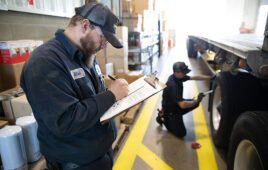 Only 22% of U.S fuel consumers report that gas prices have a “great impact” on their feelings about the economy.
Only 22% of U.S fuel consumers report that gas prices have a “great impact” on their feelings about the economy.
A majority of U.S. fuel consumers remain pessimistic about the overall state of the American economy, even as gas prices are down and expected to continue dropping, according to the latest national consumer survey released by the National Association of Convenience Stores (NACS).
Only 44% of Americans say they are “very optimistic” or “somewhat optimistic” about the economy, down three points from last month. Economic optimism is also down compared to this time last year, when nearly half (49%) reported feeling optimistic about the state of the economy.
Consumers in the Northeast are least optimistic (37%) and consumers ages 18-34 are most optimistic (51%).
U.S. fuel consumers report a median gas price of $2.10 per gallon, a 16-cent drop from July, and a total decline of 28 cents since June 2016’s summer high of $2.38.
As gas prices continue to drop, more drivers are noticing the trend. Nearly two in five (42%) fuel consumers say gas prices have declined in their area over the past 30 days, compared to 31% who said so in July when gas prices began to fall nationally.
Americans have noticed this trend in declining prices, and a majority expect low prices to continue. When asked whether they think gas prices 30 days from now will be higher or lower, nearly three in five (59%) say they expect prices next month to be the same or lower.
As has been the case throughout 2016, gas prices remain significantly lower than they have been in recent years. This month’s median gas price of $2.10 is 54 cents lower than August 2015’s median gas price of $2.64 and $1.40 per gallon lower than August 2014’s median price of $3.50.
It may be that, as gas prices drop, economic optimism becomes less dependent on the price of gas. Just one in five (22%) of U.S fuel consumers say that gas prices have a “great impact” on their feelings on the economy. This ties last month (July 2016) for the lowest number since NACS began its monthly consumer surveys in January 2013.
Consumers say their vehicle’s average fuel efficiency is 24.5 miles per gallon and average miles per dollar—a calculation that examines gas prices related to vehicle fuel efficiency—rose to 11.7 miles per dollar, the highest level since April.
“Consumer optimism has decoupled from gas price changes for only the second time in three years—and in both cases the news was dominated by politics. It’s likely that the recent political conventions pushed down optimism and the rancor of the campaigns is taking its toll on consumer optimism,” said Jeff Lenard, NACS vice president of strategic industry initiatives.
NACS, which represents the convenience store industry that sells 80% of the gas in the United States, conducts monthly consumer surveys to gauge how gas prices affect broader economic trends. The survey was conducted online by Penn Schoen Berland; 1,149 U.S. adults who purchase fuel for a vehicle such as a car, truck or van at least once per month were surveyed Aug. 2-5, 2016.




